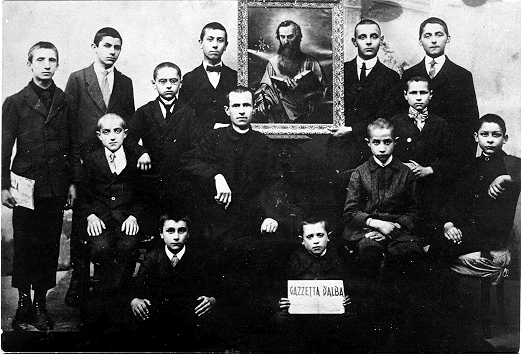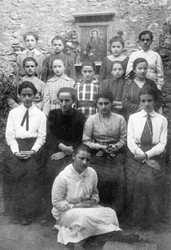Wish us a happy birth-year. This June the Daughters of St. Paul will celebrate a hundred years of participating in the mission of the Church, becoming the Good News of Jesus, and communicating him through the media within the world’s cultures. Our story would not be the same without one woman who was indispensable to its first fifty years—Thecla Merlo, well on her way now to being declared “Blessed.” Our centenary appropriately begins this year and ends next year with her anniversary—February 5.
In Alba, Piedmont, in northern Italy, Father James Alberione began the Society of St. Paul in 1914, under the name, “Little Worker Typographical School.” It consisted of a handful of boys who had enrolled to learn the printing trade. Gradually, though, as they dedicated their time to printing Catholic literature, they came to understand something of the magnitude of what they had embarked upon. Within three years, some of them would make first vows as Pauline religious.
From the earliest days, Alberione envisioned women working alongside the men to sow the seed of the Word in the minds and hearts of millions through “the good press.” So in June 1915 when he came to know Angela Boffi and 21-year-old Teresa Merlo, he saw the hand of Providence guiding the project.
 First profession of vows, 1922. Teresa Merlo, later,
First profession of vows, 1922. Teresa Merlo, later,
Sr. Thecla, co-foundress, is third from the left.
World War I had just begun. After a brief stint sewing shirts for the soldiers at the front, the young women, together with Fr. Alberione, established a sewing school. Within eighteen months, their prayer “to do the work [the boys of the School] are doing now” was answered: They began collaborating with the Typographical School to produce catechisms at an affordable price. In addition, they taught religious education classes at their parish. They soon stepped into staffing their own “New Bookstore” and, with the assistance of two boys at the School, sold books at the doors of churches. The women “did at the doors of Jesus’ ‘houses’ what the priest does from the pulpit or from the altar…” (Blessed Timothy Giaccardo, SSP).
Not everyone shared their enthusiasm. By early 1918, Fr. Giaccardo recalls, “only the first one to enter remained; all the rest left, either because their relatives had no trust in the newly founded house…or because they found the idea of women printers too unorthodox, and therefore unfit for their daughters. In the end, only four of the group remained.” Teresa’s brother, Costanzo, a priest of the archdiocese of Alba, was ridiculed also by other priests, because his sister was associated “with the Theologian,” that is, Fr. Alberione. However, Teresa remarked, “With God’s grace, their disapproval only had the opposite effect on us. We confided everything to the Theologian. Just a word from him was enough to keep us serene.”
 Dated 1917. One of the earliest extant photos of the future Society of St. Paul. Fr. Alberione is seated at the left corner of St. Paul's picture
Dated 1917. One of the earliest extant photos of the future Society of St. Paul. Fr. Alberione is seated at the left corner of St. Paul's picture
Within six months, the bishop of Susa, who wanted to resume publishing the diocesan paper, called on Fr. Alberione for his help. In turn he asked the young women if he should accept in their name. They were painfully aware of their limitations, but as Teresa wrote:
“At the moment of departure we all gathered around the Theologian….We knelt and he blessed us: he was visibly moved, and we were in tears. What a solemn moment! How much courage that blessing gave us! I still seem to feel its effects….
By 1918 they were calling themselves the Sisters of the Good Press. However, witnessing the utter trust they had in St. Paul, who protected them from one mishap after another, the people of Susa referred to them as “daughters of St. Paul,” and the name stuck.
 At Susa. Young Teresa Merlo is seated at right in the first row.
At Susa. Young Teresa Merlo is seated at right in the first row.
Their conviction and their passion for Jesus, his Gospel, and “the new means” empowered them to establish their community in the Church with joy and profound trust in God who called them together. By 1922 after making her vows, Teresa Merlo became Sister Thecla,* the first superior of that community.
Fr. Alberione never called her “co-foundress.” If he had, he would have had to appropriate the title of “founder” for himself, something he repeatedly refused to do. Still, just as his sons and daughters do look to him as founder, so they can look to M. Thecla as co-foundress—of the Daughters, certainly, but in some way also of all three of the other feminine institutes. Their first sisters came from the ranks of the Daughters and M. Thecla maternally cared for each new community.
That love spilled over into God’s people. Inspired by Fr. Alberione when she visited New York in 1949, she wrote in her journal: “In these days, I must bring before God and carry in my heart the needs of this nation and these souls. May we all fulfill God’s plan for us. Let us not place obstacles in his way.”
In 1964 Fr. Alberione highlighted this nurturing aspect of her calling when he said to the Daughters immediately after her death:
“You will have other Prima Maestras, but only she was above all the Mother of the Institute…. Not only with her prayers, but in various ways and means, she directly or indirectly contributed to all the other institutions of the Pauline Family.” (Here he names all ten branches, including the masculine ones.) “What a great heart! Conformed to the Heart of Jesus.”
Do you want to feel the beating of this heart for you? Click here for the prayer for her intercession and join the tens of thousands who have entrusted to her their needs and desires, no matter how small.
* “Sister” was not used at first, but Maestra, or teacher, in honor of Jesus the Divine Master and to better highlight the teaching vocation of each sister in the community. “Mother” was never used, but is common now when referring to Thecla Merlo, out of popular usage in the Church when referring to foundresses.